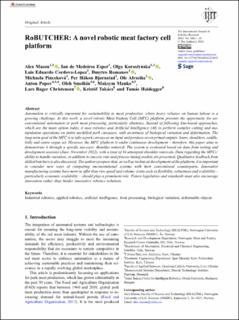| dc.description.abstract | Automation is critically important for sustainability in meat production, where heavy reliance on human labour is a growing challenge. In this work, a novel robotic Meat Factory Cell (MFC) platform presents the opportunity for un- conventional automation in pork meat processing, particularly abattoirs. Instead of following line-based approaches, which are the main option today, it uses robotics and Artificial Intelligence (AI) to perform complex cutting and ma- nipulation operations on entire unchilled pork carcasses, with awareness of biological variation and deformation. The long-term goal of the MFC is to take a pork carcass as an input and produce seven primal outputs: hams, shoulders, saddle, belly and entire organ set. However, the MFC platform is under continuous development – therefore, this paper aims to demonstrate it through a specific use-case: shoulder removal. The system is evaluated based on data from testing and development sessions (June–November 2022), with a total of 34 attempted shoulder removals. Data regarding the MFCs’ ability to handle variation, in addition to success rate and process timing models are presented. Qualitative feedback from skilled butchers is also discussed. The authors propose that, as well as technical development of the platform, it is important to consider new ways of comparing unconventional systems with their conventional counterparts. Innovative manufacturing systems have more to offer than raw speed and volume; traits such as flexibility, robustness and scalability – particularly economic scalability – should play a prominent role. Future legislation and standards must also encourage innovation rather than hinder innovative robotics solutions. | en_US |

